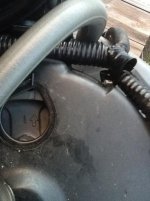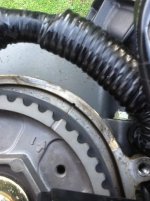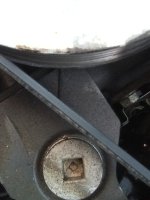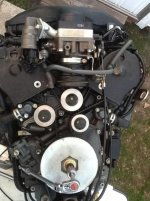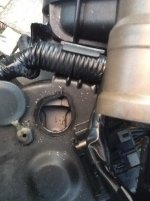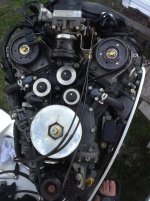I just did a decarb on my pair of BF200's today. Ran on a concentrated small tank with sea foam, then let sit and finished with a few long runs up to WOT. The engines seemed to run fine before this, but are approaching 1k hrs, so figured it was a good idea to do them. I bought the boat used, so have only run it for one season. The fuel mileage is not great, but they run well. They are 2003 BF 200's on a 2660 Prokat. I am running 14 1/4 x 17 3 blade ss Solas props. At WOT the port engine was burning 21gph at 5500 rpms on my floscan, where the stbd was only burning 16gph at the same. The stbd will turn 6k with the engines trimmed down but the port will only turn 5500. If I trim up I can get the port to 56-5700 max, but the stbd can turn over 6k trimmed up. I have noticed this fuel burn difference since I got the boat. I cruise at 28 mph and burn about 9-10 gph stbd and 10-11 gph port, even if I run the port at say 41-4200 and the stbd at 44-4500 rpm. I have to offset the rpms to try and keep them in a relatively close burn rate. Since I got the boat about a year ago I have replaced the racors, the fuel filters on the engines, drained the vst's, changed the plugs, cleaned the IAC's, decarbed, replaced both O2 sensors, new water pump kits, gear oil,thermostats,manifold zincs, and just removed the injectors on the port engine and had them cleaned and tested. The port runs a little bit rougher at idle on the flusher than the stbd does but they both run strong at anything above idle. I am not sure if the decarb smoothed out the idle on the port or not as I have not run it on the muffs yet. The decarb was done in freshwater, so I just used the flush port when I came back. I put the old plugs and O2 sensors back in to do the decarb, so I plan to swap them back tomorrow. Any ideas what may cause the port to burn so much more fuel than the stbd? The port is a counter rotator and has a new gear case on it. I was not under the impression there were any changes to the ratios, but the new case does look slightly different than the stbd. Other than that, the engines are identical. I do run ethanol but keep the fuel treated and the tanks full at all times. I have seen no sign of water in the racors or the vst's since day one,so I don't believe the fuel quality is an issue.
Home
Outboard Motor Parts
Chrysler outboard parts Evinrude outboard parts Force outboard parts Honda outboard parts Johnson outboard parts Mariner outboard parts Mercury outboard parts Suzuki outboard parts Tohatsu outboard parts Yamaha outboard partsInboard & Sterndrive Engine Parts
Chrysler Marine inboard parts Crusader Marine parts MerCruiser sterndrive parts OMC sterndrive parts Pleasurecraft Marine parts Volvo Penta marine parts + MoreAll Engine Brands
All Manuals HomeOutboard Repair Manuals
Chrysler outboard manuals Evinrude outboard manuals Force outboard manuals Honda outboard manuals Johnson outboard manuals Mariner outboard manualsMercury outboard manuals Nissan outboard manuals Suzuki outboard manuals Tohatsu outboard manuals Yamaha outboard manuals
Inboard & Sterndrive Engine Manuals
MerCruiser sterndrive manuals OMC sterndrive manuals Volvo Penta marine engine manualsPlease Note
MarineEngine.com does not offer troubleshooting assistance or repair advice by email or by telephone.
You are invited to join our public Boat Repair Forum to seek assistance from other members.
You may also visit the Boat Motor Manuals section of our site to obtain a service manual.


